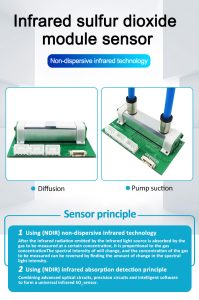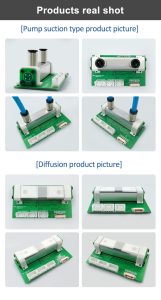Environmental pollution has become a pressing global issue that requires effective control and monitoring measures. In recent years, gas sensors have gained significant importance in environmental pollution control efforts. These sensors play a crucial role in measuring and detecting various gases and pollutants, providing accurate data for pollution control strategies. This article explores the growing importance of gas sensors in environmental pollution control, their applications, challenges, and future prospects.
The Need for Environmental Pollution Control:
Environmental pollution poses severe threats to ecosystems, human health, and the planet as a whole. It is crucial to monitor and control pollution levels to mitigate its adverse effects. Gas sensors serve as essential tools in this process, enabling precise and real-time measurements of gases emitted from industrial activities, transportation, agriculture, and other sources.
Gas Sensor Technology and Working Principles:
Gas sensors utilize different sensing technologies such as electrochemical, semiconductor, and optical methods. These sensors are designed to detect specific gases and pollutants through chemical reactions or changes in conductivity or light absorption. They are highly sensitive, capable of measuring even trace amounts of pollutants.
Monitoring Air Quality:
Gas sensors are instrumental in monitoring air quality, providing valuable data on the concentration levels of gases such as nitrogen dioxide (NO2), sulfur dioxide (SO2), ozone (O3), carbon monoxide (CO), and volatile organic compounds (VOCs). Real-time monitoring using gas sensors helps identify pollution hotspots and trends, enabling prompt action to reduce emissions and improve air quality.
Environmental Impact Assessments:
Gas sensors play a vital role in conducting environmental impact assessments before the establishment of new industries, power plants, or infrastructure projects. These sensors help measure the baseline pollution levels and predict potential emissions from the proposed activities. This data assists in making informed decisions, implementing appropriate mitigation measures, and ensuring compliance with environmental regulations.
Industrial Emission Monitoring:
Gas sensors are extensively used for monitoring and controlling emissions in industrial settings. They help detect and measure gases emitted during manufacturing processes and energy generation, such as carbon dioxide (CO2), nitrogen oxides (NOx), methane (CH4), and particulate matter (PM). By continuously monitoring these emissions, industries can identify inefficiencies and implement measures to reduce pollution levels.
Water and Soil Pollution Control:
Gas sensors are not limited to air quality monitoring; they also play a significant role in water and soil pollution control. These sensors can detect gases released from contaminated water bodies or soil, such as ammonia (NH3), hydrogen sulfide (H2S), and volatile organic compounds (VOCs). Early detection allows for timely intervention, preventing further contamination and protecting ecosystems.
Environmental Remediation:
Gas sensors are valuable tools in environmental remediation projects aimed at restoring polluted areas. By continuously monitoring the concentration of gases in the air, water, or soil, gas sensors provide critical data to assess the effectiveness of remediation efforts. This feedback allows for adjustments and improvements in remedial actions, leading to more efficient pollution control.
Integration with Internet of Things (IoT) and Big Data Analytics:
The integration of gas sensors with IoT technologies and big data analytics has revolutionized environmental pollution control. Gas sensors connected to IoT platforms can constantly transmit data to centralized systems, enabling real-time monitoring and analysis. By leveraging big data analytics, patterns and trends in pollution levels can be identified, allowing for targeted interventions and predictive modeling for pollution control strategies.
Challenges and Future Prospects:
Despite the advancements in gas sensor technology, several challenges remain. Calibration, sensor drift, and cross-sensitivity to other gases are ongoing concerns that need to be addressed. Additionally, the affordability and accessibility of gas sensors need improvement to encourage wider adoption, especially in developing countries. However, ongoing research and development efforts are promising, with the potential for smaller, more accurate, and cost-effective sensors that can monitor an extensive range of gases.
Conclusion:
Gas sensors play an increasingly critical role in environmental pollution control measures. They provide accurate, real-time data for monitoring air, water, and soil pollution, which facilitates effective decision-making and implementation of pollution control strategies. As technology advances and costs decrease, gas sensors will become even more accessible, enabling widespr
 : +86 155 8830 2704
: +86 155 8830 2704 : jxdziot@gmail.com
: jxdziot@gmail.com
